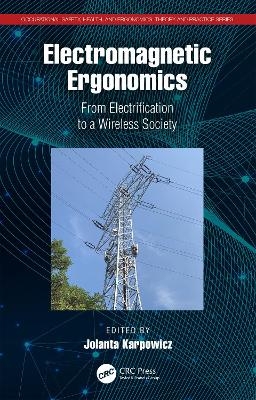
Electromagnetic Ergonomics
CRC Press (Verlag)
978-1-032-52913-4 (ISBN)
Ergonomics is the branch of engineering science in which biological science is used to study the relationship between workers and their environments. Because of the use of electricity for many purposes, one environmental factor that has become omnipresent today is the electromagnetic field, also referred to as electromagnetic radiation or a fraction of the non-ionizing radiation. The complex interactions of electromagnetic energy with material objects contribute to ergonomics issues because they can cause health hazards in workers, trigger accidental situations, limit the ability of workers to work safely and disturb the function of electronic devices, including medical implants, etc. A better understanding of complex electromagnetic issues in the work environment is considered in this book.
This title will be beneficial to workers affected by electromagnetic hazards including wireless transfer of information or power, wireless (induction) heating, joining metal elements with electric-supplied techniques, capacitive heating of dielectric materials, physiotherapeutic or cosmetic electromagnetic treatments, antitheft gates and other monitoring or control systems using wireless solutions, electric transportation and many more. It will help prevent common misunderstandings about electromagnetic hazards and sufficiently reduce where they appear.
Electromagnetic Ergonomics is designed to have a positive influence on public health and worker safety in the work environment and brings broad benefits, in particular with respect to research planning and the interpretation of the results, as well as the implementation of science-based evidence regarding the evaluation and elimination of EMF hazards in the operations of enterprises and environmental, labor and sanitary inspections, as well as government regulators responsible for environmental safety issues in the workplace and the daily life environment.
Jolanta Karpowicz received her master’s and engineering degree in medical and nuclear electronics (1990) and has a DSc (habilitation) in biomedical engineering (2020) from the Warsaw Technical University (Poland), as well as a PhD (doctorate) in environmental engineering (2004) from the Central Institute for Labour Protection – National Research Institute (CIOP-PIB) (Warszawa, Poland), where she is a researcher, the head of the Bioelectromagnetics Department (research unit, as well as a laboratory accredited in the evaluation of electromagnetic fields and the calibration of measurement devices). Her main area of research is the electromagnetic environment and its influence on humans and environmental safety, focusing primarily on worker safety – through measurements, numerical modelling, safety standardisation, and legislation, as well as education under national research programmes and international collaboration (such as European Framework Programmes and The European Cooperation in Science and Technology, known as COST Actions). She has contributed to over 100 journal research articles and conference short papers, and more than 400 expert opinions in the field of evaluating electromagnetic hazards commissioned mainly by industry and healthcare institutions. She also serves as a reviewer for many international scientific journals (such as JOSE, Bioelectromagnetics, IJERPH, Int. J. Radiobiology). She is a member of the Bioelectromagnetics Society (BEMS), the European Bioelectomagnetics Association (EBEA) and the Int. Commission on Occupational Health (ICOH), as well as the Polish Society of Radiation Research (PTBR) and the Polish Society of Biomedical Engineering (PTIB affiliated to the Int. Federation for Medical and Biological Engineering (IFMBE)). Her activities also cover collaboration with international scientific and technical bodies: the International Union of Radio Science (URSI, Commission K - Electromagnetics in Biology and Medicine), the Institute of Electrical and Electronics Engineers/International Committee on Electromagnetic Safety (IEEE/ICES) and the International Electrotechnical Commission (IEC)/(European Committee for Electrotechnical Standardization (CENELEC). She was an expert in electromagnetic hazards at work to the European Council, the European Commission and the Ministry of Labour in Poland (among other things as a member of the Interdepartmental Commission for the Maximum Admissible Concentrations and Intensities for Agents Harmful to Health in the Working Environment in Poland and vice-chair of the group on Electromagnetic Fields of Panel of Experts on Physical Factors at this commission).
1. Electromagnetic Fields in Human History. 2. Electromagnetic Formalities Regarding Work-related Environmental Issues. 3. Estimating Uncertainty in Assessments of Exposure to Radiofrequency Electromagnetic Fields. 4. Evaluation of Electromagnetic Exposure during Workers’ Activities near High Voltage Electricity Grids. 5. Long Term Evaluation (2010-2018) of General Public and Occupational Electromagnetic Fields Exposure in Radiocommunication Antenna Parks Across Greece. 6. Pulsed Microwave Exposure of Humans: Specific Analyses and Forms of Protection. 7. The Health Surveillance of Workers with Occupational Exposure to Electromagnetic Fields and the Problem of “Workers at Particular Risk”. 8. Evaluating Current Induced in Limb when Managing Electromagnetic Hazards caused by Operating Electrosurgical Units. 9. Electromagnetic Safety and Smart Wireless Solutions. 10. The Significance of a Posture-related Evaluation of the Electromagnetic Influence from Hand-operated Devices. 11. Managing Electromagnetic Hazards by Applying Non-binding Safety Measures. 12. Occupational Exposure to the Electromagnetic Field and Precautionary Approaches to Health Issues.
| Erscheinungsdatum | 11.07.2023 |
|---|---|
| Reihe/Serie | Occupational Safety, Health, and Ergonomics |
| Zusatzinfo | 33 Tables, black and white; 41 Line drawings, black and white; 26 Halftones, black and white; 67 Illustrations, black and white |
| Verlagsort | London |
| Sprache | englisch |
| Maße | 156 x 234 mm |
| Themenwelt | Technik ► Bauwesen |
| Technik ► Elektrotechnik / Energietechnik | |
| Technik ► Umwelttechnik / Biotechnologie | |
| Wirtschaft | |
| ISBN-10 | 1-032-52913-X / 103252913X |
| ISBN-13 | 978-1-032-52913-4 / 9781032529134 |
| Zustand | Neuware |
| Informationen gemäß Produktsicherheitsverordnung (GPSR) | |
| Haben Sie eine Frage zum Produkt? |
aus dem Bereich


